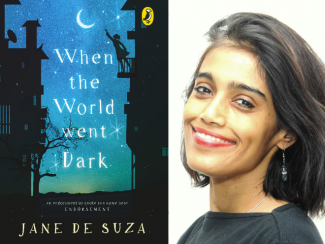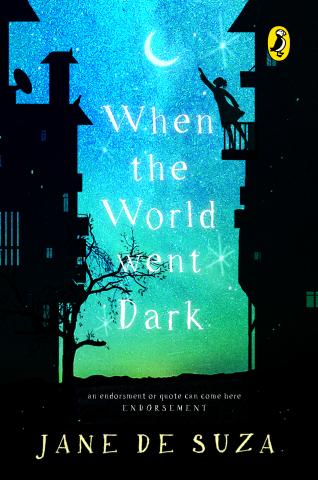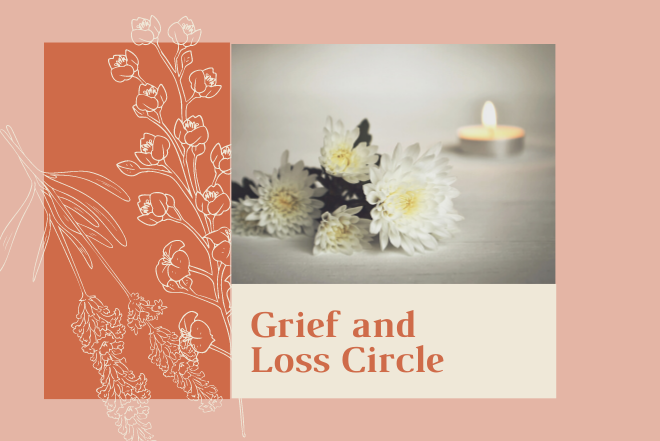
Jane De Suza’s latest book ‘When the World Went Dark’ weaves a charming story amidst the backdrop of the pandemic with death and loss understood from the consciousness of a nine-year-old child. Our editor Shivani Maheshwari reviews it.
Here is a sweet little book that will make an interesting read for children, as well as adults. It has Covid 19, loss, bereavement, as the framework, and the foreboding title ‘When the World Went Dark’. But it far from a depressing, dry pandemic chronicle. Rather it is a fast paced, easy to read book that keeps you curious and happily turning the pages till the end.
Narrated by precocious nine-year-old Swara about her life with her family and friends, and the criminal doings she sharply sniffs out during the lockdown, it is skilfully woven with some frightening and funny bits about home confinement.
Set in Bangalore, in a large housing complex, Swara’s world has shrunk to sightings from a solitary window frame from where she can see the street, buildings and shops located across the street – all of which play key elements as the suspense unfolds.
Her favourite person in the world is Pitter Paati (PP), her grandmother, who lives away from her with her uncle on the outskirts of Bengaluru. She is Swara’s best friend, her favourite and most loved. Swara would have video chats with PP many times a day, share her new poem, show her the desolate street outside, her fake moustache. As Paati loved crime thrillers and detective fiction featuring Feluda, Karamchand and most of all, Miss Marple, she would affectionately call Swara ‘Little Miss Marble’. Indeed Swara had the trappings of a little detective. She was adventurous, inquisitive, an imaginative kid, not willing to capitulate easily.
When Paati falls ill and dies of corona, Swara is perplexed. She finds it difficult to comprehend and reconcile her going away forever. She can’t believe that her Paati has disappeared without telling her. ‘VRidiculours! VRubbish!’ She imagines that Paati was setting her a real-life mystery with clues scattered about the house to find her again. Swara has conversations with her and feels her presence in all activities. In fact, it is her Paati who leads her to the final detective which lives up to the name Miss Marble.
Pitter Paati was full of fun.
She brought me up from when I was one.
Because Amma Appa went to office.
Author Jane De Suza’s vivid imagination steps into Swara’s psyche with great wit and realism. We can almost see Swara sparring with her elder brother, Rishi, reaching out to her friends in the building, cozying up to her mom with feelings of anxiety and sharing her fears during her online classes.
PP’s presence lingers through the book and eventually leads Swara to spot the mysterious occurrences in sari shop opposite her flat. Her probing mind takes it upon herself to get to the bottom of the intriguing, suspicious goings-on especially when all shops are closed and all activity has come to the standstill at the height of the lockdown. She perseveres with the quest inspired by little imaginary leads from her PP, and ropes her brother and friends. Through her keen observance from the home window, she is able intercept a major crime.

When the World Went Dark harks back to the roster of sleuths and kid detectives. You are reminded of Enid Blyton and Nancy Drew detective thrillers. But what warms the heart is the local, home-grown flavour and the gentle understanding of loss and death through a child’s perspective. Swara never reconciles to her PP’s death, and believes she will return one day. Her imagination continues to weave Paati’s magic on her. Her childlike explanatory drawings add charm to the pages and bring Swara closer to the readers.
Interwoven through the narrative are glimpses of the lockdown with millions infected and dying, overriding anxiety and fear, loss of jobs and incomes, uncertainties, social distancing, separation from loved ones, masks – a ubiquitous symbol of the pandemic, clapping hands and lighting diyas to cheer health workers and virtual classes. The entire scale and gamut of the pandemic is filtered through Swara’s consciousness in the book.
I would recommend this book to anyone with a sense of humour and wanting to relive the childhood memories and moments. If you want read about the hilarious and daring adventures of a girl, and her Sherlock Holmes streak, then this is for you.
In the last few pages, Jane writes that the book was born out of repressed feelings and unresolved sentiments. “When my boys lost their grandmother, I went about it all wrong. I buried my own feelings and distracted theirs in a frantic rush to face the world as normal, to return to them what I perceived as their required state of equilibrium. I messed up. Over the years, I have delved deeper into better ways to healing. This book comes from that personal space. It is a look at loss through the uncomprehending eyes of children, and let them know it is okay.”
The author also gives some helpful tips to recognise unsettled pain and unexpressed distress that may need to be addressed. “When the child shows physical symptoms like persistent stomach or headaches of fears that hinder their usual activities (like refusing to play outdoors) or fantasies of rejoining a loved one soon or avoids conversations about the departed person. Note any unexplained change in behaviour, eating, sleeping, anger or withdrawal – and talk to a medical health professional about them.”
In When the World Went Dark, Jane has spun an endearing tale held together by strands of wit, humour, imagination, suspense and easily relatable anecdotes. It will contribute significantly to the assemblage of young detectives.
Struggling with grief, join the closed community - Grief and Loss circle







